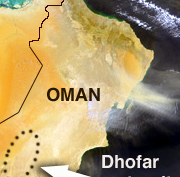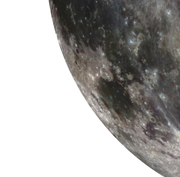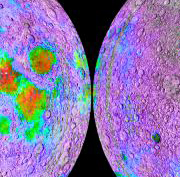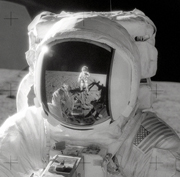Official Name:
This is the 26
th meteorite discovered in the province of Dhofar.
Location:
Dhofar is a province in Oman, a country on the Arabian peninsula.
Fall or Find:
Dhofar 026 is a find. It has been little altered by Earth's climate, which means that it did not spend a long time on the ground before being found.

Enlargement
Map of the Arabian Peninsula showing the Dhofar meteorite collection area, in southern Oman. |
|
|
Date:
6 March 2000
Mass Recovered:
148 grams
Number of Fragments:
One small, spherical fragment has been recovered.
Circumstances:
The individual who discovered Dhofar 026 has remained anonymous. It was probably a Bedouin (a member of a nomadic Arab tribe) who found the meteorite and sold it to a collector.
The meteorite Dhofar 026 has no fusion crust, and its surface is greyish brown. There are many vesicles inside the rock.
Type:
Stony meteorite
Class:
Achondrite
Group:
Lunar
Composition:
This meteorite is a breccia, which means that it is made of broken pieces of silicates in a fine matrix. Most of the rock is composed of irregular fragments mixed with plagioclase, olivine, and pyroxene. Lunar breccias are formed during impacts of objects with the dusty surface of the Moon.

Enlargement
The lunar maria are the smoother, darker areas that can be seen by the naked eye. The highlands are lighter coloured and cratered. |
|

Enlargement
Map of the distribution of iron on the surface of the Moon. The areas where the meteorite Dhofar 026 may have come from contain about 5% iron and are shown in blue. |
|
Scientific contribution:
This meteorite has been compared to samples of lunar rocks collected by the astronauts on the Apollo missions. Its lunar origin has been confirmed. Its relatively high iron content (4.8%) suggests that Dhofar 026 may come from the lunar highlands, rather than the lunar maria (seas). Scientists have even been able to identify some more precise areas-on both the Moon's visible and hidden sides-from which this meteorite may have come.

Enlargement
Apollo 12 astronaut Alan Bean holds a special container used to collect samples of lunar soil. |
|
Comments:
Both Dhofar 025 and 026 are lunar achondrites. Their textures and compositions are completely different, but scientists have not eliminated the possibility that they may be two fragments of the same meteorite. They were discovered 20 kilometres from one another.
Part of the Planétarium's collection:
No